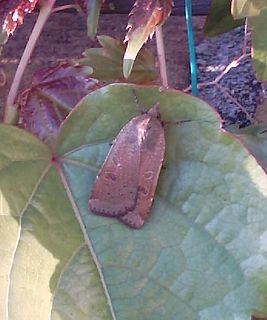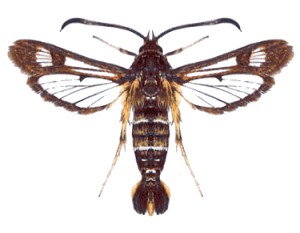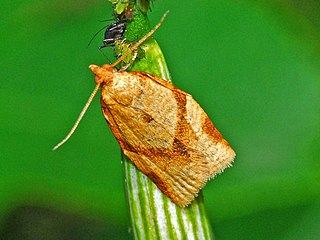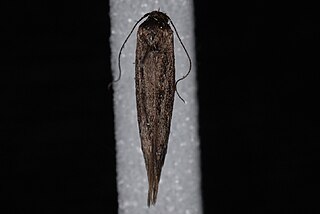
Common sorrel or garden sorrel, often simply called sorrel, is a perennial herb in the family Polygonaceae. Other names for sorrel include spinach dock and narrow-leaved dock. It is a common plant in grassland habitats and is cultivated as a garden herb or salad vegetable.

The docks and sorrels, genus Rumex, are a genus of about 200 species of annual, biennial, and perennial herbs in the buckwheat family, Polygonaceae. Members of this genus are very common perennial herbs with a native almost worldwide distribution, and introduced species growing in the few places where the genus is not native.

The heart and dart is a moth of the family Noctuidae. The species was first described by Carl Linnaeus in his 1758 10th edition of Systema Naturae. A familiar moth to many, it is considered one of the most common of the European region. It occurs throughout the Palearctic ecozone from Ireland to Japan.

The lesser yellow underwing is a moth of the family Noctuidae.

Rumex obtusifolius, commonly known as bitter dock, broad-leaved dock, bluntleaf dock, dock leaf or butter dock, is a perennial plant in the family Polygonaceae. It is native to Europe, but is found on all temperate continents. It is a highly invasive species in some zones, resulting from its abundant seed dispersal, adaptability to reproduce, aggressive roots, ability to tolerate extreme climates, and hardiness.

Pyropteron doryliformis, the dock clearwing or dock moth, is a moth of the family Sesiidae. It is found in south-west Europe, North Africa and Australasian realm.

Clepsis consimilana, the privet tortrix, is a moth of the family Tortricidae.

Enteucha acetosae, the pygmy sorrel moth, is a moth of the family Nepticulidae. It is found from Sweden to the Pyrenees, Alps and Serbia and from Ireland to Romania.
Bactra venosana, the nutgrass borer or nutsedge borer, is a moth of the family Tortricidae. It was first described by Philipp Christoph Zeller in 1847. It has a wide distribution, from southern Europe, North Africa and Asia Minor to India, Sri Lanka, southern China, Malaya, Australia and into the Pacific where it is found on Java, Borneo, the Philippines, Taiwan, Timor, the Solomons, the Carolines and Fiji. It was introduced to Hawaii in 1925 to control nutsedge. It is now found on Kauai, Oahu, Molokai, Maui, Lanai and Hawaii.

Crombrugghia distans is a moth of the family Pterophoridae. It is found in almost all of Europe, as well as Asia Minor, North Africa and the Canary Islands. It is also known from India, Iran and Afghanistan.

Manulea pygmaeola, the pigmy footman, is a moth of the family Erebidae. It is found in the western half of the Palearctic ecozone, east to Altai.

Calybites phasianipennella is a moth of the family Gracillariidae. It is known from all of Europe and most of Asia.

Coleophora conspicuella is a moth of the family Coleophoridae found in Asia and Europe. It was first described by Philipp Christoph Zeller in 1849.

Scythris cicadella, the sand owlet, is a moth of the family Scythrididae. It was described by Philipp Christoph Zeller in 1839. It is found in central and south-western Europe. The habitat consists of dry or sandy soil.

Cochylis pallidana, the sheep's-bit conch, is a moth of the family Tortricidae. It was described by Zeller in 1847.

Scythris noricella is a moth of the family Scythrididae. It was described by Philipp Christoph Zeller in 1843. It has a Holarctic distribution. In Europe, it is found on most of the continent, except Ireland, Great Britain, the Netherlands, Denmark, the Iberian Peninsula, the Baltic region and most of the Balkan Peninsula.

Scythris sinensis is a moth of the family Scythrididae first described by the Austrian entomologists Baron Cajetan von Felder and Alois Friedrich Rogenhofer in 1875. The moth is found in Asia, Europe and North America.
Scythris tributella is a moth of the family Scythrididae. It was described by Zeller in 1847. It is found in central and southern Europe, North Africa (Libya) and Russia, Georgia, Turkey and Turkmenistan.
Scythris fallacella is a moth of the family Scythrididae found in Europe.

Scythris grandipennis is a moth of the family Scythrididae found in Europe.

















